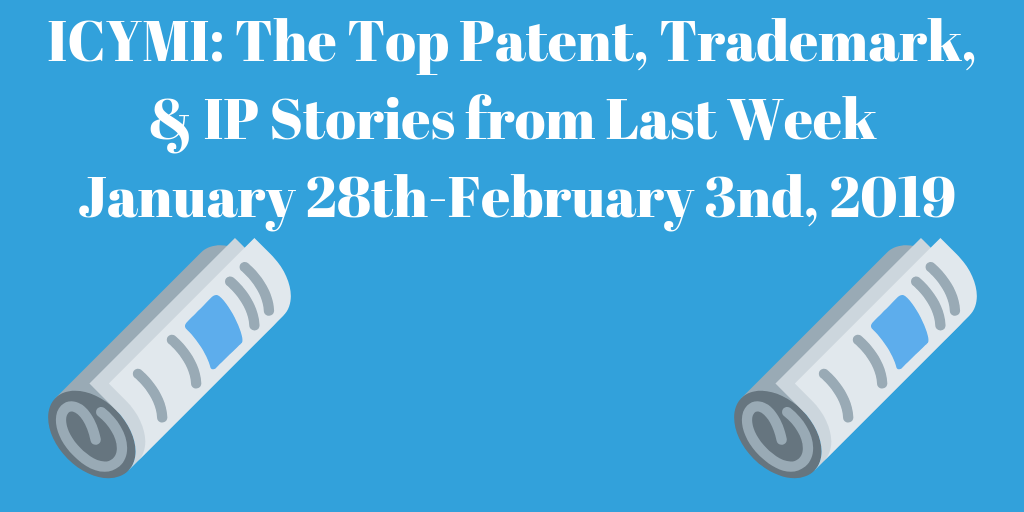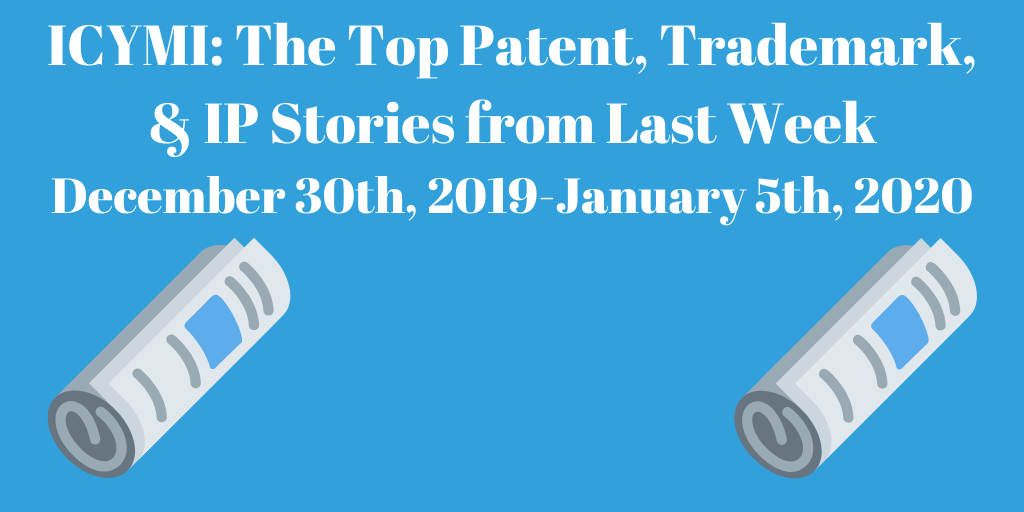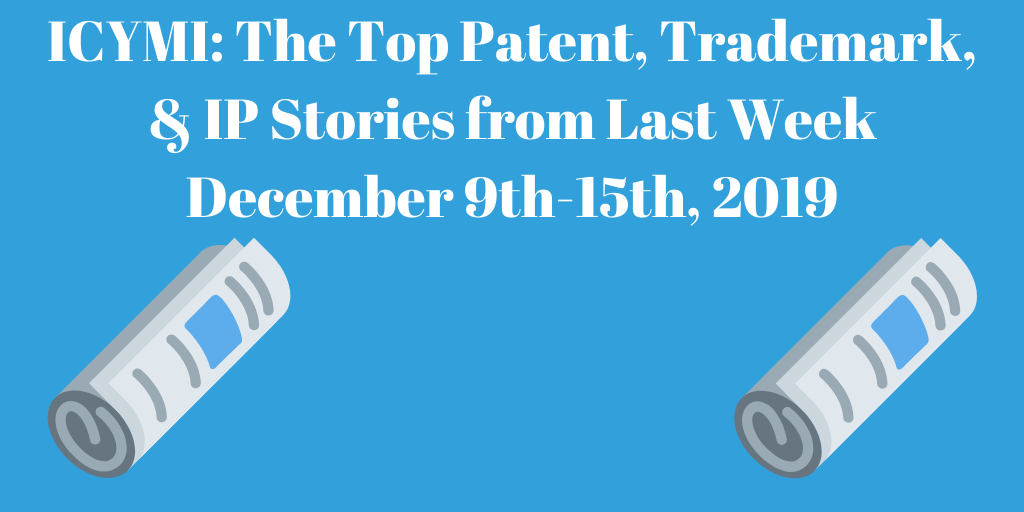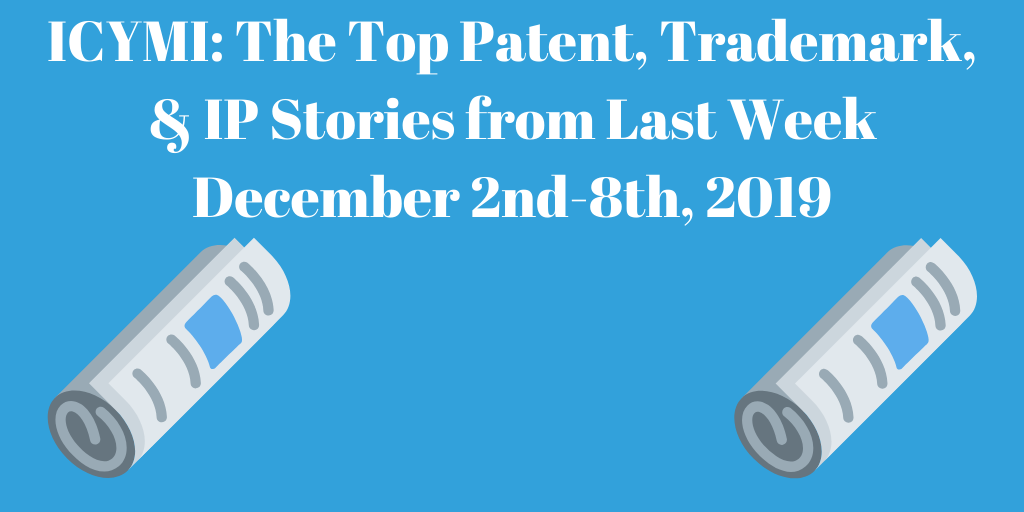Top Patent, Trademark, and IP Stories from Last Week (1/28-2/3/19)
ICYMI: The Top Patent, Trademark, and IP Stories from Last Week (January 28th-February 3rd, 2019)
Every week, we will be highlighting the top patent, copyright, trademark, intellectual property, etc. stories of the previous week in our “In Case You Missed It” segment. The list itself is in no particular order and includes a wide range of stories from the patent world that are informative, noteworthy, or just plain bizarre. The stories included encompass everything from Supreme Court cases to insights into emerging industries. Please feel free to comment your thoughts on the stories or share an important one we missed!
1.) “Lessons From McDonald’s Global Trademark Battles”
A few weeks back we covered McDonald’s surprising defeat to Supermacs, an Irish hamburger chain, over the “Big Mac” trademark. In that case the European Union Intellectual Property Office found McDonald’s was “trademark bullying” by preventing Supermac’s ability to expand throughout Europe. The case resulted in McDonald’s losing the right to use the name “Big Mac” on products sold in the EU.
The unprecedented decision has brought about new considerations for brands who wish to expand internationally. Although laws vary from country to country, most laws follow basic principles and companies should consider those from the start. That said, there are some noteworthy lessons companies should learn from McDonald’s global trademark battles over the years.
For one, companies should consider trademarks that do not confuse customers with other brands or products sold by other brands. For example, McDonald’s argued Supermac’s name would cause confusion with consumers because of how closely it sounded to “Big Mac.”
Secondly, trademarks should relate to the business and not be so ambiguous that it impedes on other unrelated businesses. For example, a Singapore court denied McDonald’s request to use the prefix “Mc” and “Mac” in favor of Future Enterprises Private Ltd. who had already applied for trademark registration on products including “Mac Tea” and “Mac Noodle.” In that case the court determined such prefixes would not deceive or confuse customers as packaging was not visually similar and the products were sold in supermarkets vs. in restaurants. That was not the case in Europe however where the EU court backed McDonald’s exclusive rights to the “Mc” and “Mac” prefixes in their product trademarks in a dispute with the same company. Again, it depends on the country.
Another lesson is to consider menu type similarities with competitors when potentially infringing on trademarks. In 1996, McDonald’s was successfully able to prevent an Indian restaurant named “McIndians” from using their trademark because they also sold hamburgers and fries. Conversely, McDonald’s was unsuccessful in preventing a Chinese restaurant named “McChina” from using their trademark because they sold only Chinese food.
The final lesson to consider is the date of trademark registration and actually using that trademark. Using a trademark after registering it is just as important as registering it in the first place. Despite registering for the “Big Mac” trademark in the Philippines in 1985, McDonald’s ultimately lost a case against Big Mak Burger who tried to register their trademark in 1988. In this case, it was ultimately up to the local judges who believed there was no ill will on behalf of Big Mak and that the color schemes were different.
To read more about this story, click here (via Forbes, February 2nd, 2019)
2.) “Boom in Artificial Intelligence Patents, Points to ‘Quantum Leap’ in Tech: UN Report”
A new report by the World Intellectual Property Organization (WIPO) reveals an “upsurge” in artificial intelligence (AI) patent applications over the past 5 years. The report highlights how devices powered by AI will revolutionize every aspect of daily life- from transportation to healthcare. I have outlined some of the surprising revelations from the report on AI-related patent filings which can be read here.
Highlights from the report:
-
- 340,000 AI patent applications have been submitted since the 1950’s, 50% of which were published just over the past 5 years
-
- The ratio of AI scientific papers to inventions has decreased significantly (8:1 in 2010 to 3:1 in 2016) indicating a shift from theoretical research to the development of tangible AI technology
-
- ”Machine learning” is the most dominant AI technique in terms of patent filings, making up one-third of all AI-related patents (134,777) and growing annually at a rate of 28%
-
- “Deep learning” is the fastest growing AI technique, growing at an average annual rate of 175% between 2013 to 2016
-
- “Neural networks” technology also saw impressive expansion in patent filing, growing at a rate of 46% in the same period
-
- Of all AI-related patents, “computer vision” (including image recognition) is mentioned in 49% of them with an annual growth rate of 24%
-
- AI patent filings for robotics saw the highest growth rate, 55% per year from 2013-16
-
- In comparison, patent filings across all technological sectors grew by only 10% in that same period
-
- By industry, transportation and telecommunications dominate patent applications, compromising 15% of all patents apiece. These are followed by life and medical science (12%), computers and personal devices (11%), and security, banking, manufacturing, entertainment, etc.
-
- For highest annual growth rates in terms of patent filings by industry, transportation (33%) including aerospace (67%) and autonomous vehicles (42%) led the way in 2013-16. Telecommunications grew by an average of 23% annually, life and medical devices (12%), personal devices and computers (11%).
-
- Of the top 20 companies filing AI-related patents, 12 were from Japan, 3 from the U.S., and 2 from China
- IBM leads all companies in terms of AI patents with 8,290
To read more about this story, click here (via United Nations, January 31st, 2019)
3.) “Amazon Patents a Plan to Have Packages Ride Public Buses for Customer Pickup”
In a more bizarre story from last week, Amazon successfully published a patent for “mobile pickup locations” that are essentially mobile storage compartments on public buses. Customers who ride the bus or are close to a bus stop will be able to select the time and place to retrieve their packages if they so choose.

The patent indicates customers will not need to enter the bus, the ability to retrieve their package from the bus’s exterior will be possible as well. Storage compartments will be opened via a unique access code on each compartment.
The compartments will not be so different from Amazon’s countrywide implementation of 2,800 lockers which also require a passcode and are optional. The lockers in place now are beneficial to customers in apartment buildings and shady neighborhoods where packages are often stolen. Amazon’s patent indicates mobile pickup locations will be useful to customers in remote villages where on-time delivery may be troublesome.
To read more about this story, click here (via GeekWire, January 31st, 2019)
4.) “Remarks by Director Iancu at the Artificial Intelligence: Intellectual Property Considerations Event”
Last week, USPTO Director Andrei Iancu addressed the rise of artificial intelligence and its implications on intellectual property law and sustaining innovation in America. Those in attendance included AI leaders, policy makers, academics, and practitioners.
“We provide our IP expertise and leadership to U.S. government officials, foreign governments, and others on a wide-ranging portfolio of domestic and international policy matters, including on how best to protect and enforce IP rights in the face of emerging technologies like artificial intelligence and machine learning,” Iancu remarked.
Iancu went on to address efforts at the USPTO to utilize AI for advanced patent searches, calling on those in attendance to help. Given the backlog at the USPTO, anything will help. Iancu indicated the USPTO had sent out Requests for Information (RFI) to industry leaders for help to improve patent searches with AI technology.
The RFI asked professionals four questions:
-
- How can we effectively and consistently search further?
-
- How can we segment information more effectively?
-
- How can the USPTO patent search retrieve the most relevant results—not just more results—from a broader corpus?
- How can we review the search results more quickly?
The results of the RFI led to the development of a new tool called “U,” or “Unity,” that will use AI and machine learning to “conduct a ‘federated search’ across patents, publications, non-patent literature, and images” with a single click. Another tool being developed will be able to search across technology-specific synonyms. This will aid in bringing prior art to the surface faster and more thoroughly than conventional methods.
Iancu left policy makers with questions to consider:
-
- Whether the legal concepts of inventor or author will be fundamentally changed by AI
-
- Who retains title to an improvement developed by a machine? The original programmer, machine owner, or even the machine, itself?
-
- Should using copyrighted works to “train” AI systems constitute fair use or some other exception?
-
- How do we assess patentability as well as the risk of bias when there is little transparency regarding how algorithms are trained and function?
- How will firms, both large and small, protect AI-related inventions?
To read more about this story, click here (via USPTO, January 31st, 2019)




